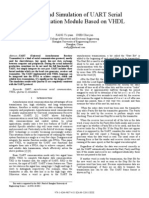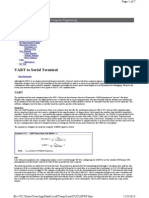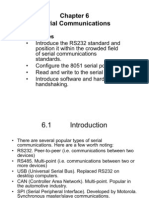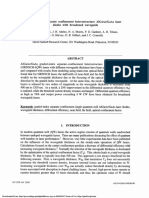Synthesis and FPGA Implementation of UAR PDF
Synthesis and FPGA Implementation of UAR PDF
Uploaded by
quang nguyenCopyright:
Available Formats
Synthesis and FPGA Implementation of UAR PDF
Synthesis and FPGA Implementation of UAR PDF
Uploaded by
quang nguyenOriginal Title
Copyright
Available Formats
Share this document
Did you find this document useful?
Is this content inappropriate?
Copyright:
Available Formats
Synthesis and FPGA Implementation of UAR PDF
Synthesis and FPGA Implementation of UAR PDF
Uploaded by
quang nguyenCopyright:
Available Formats
IJSRD - International Journal for Scientific Research & Development| Vol.
1, Issue 9, 2013 | ISSN (online): 2321-0613
Synthesis & FPGA Implementation of UART IP Soft Core
Sohini Chatterjee1 Sona Gava2 Shreya Sharan3 Sonam Sinha4 Subir Maity5
1,2,3,4
B. Tech Student 5Assistant Professor
1,2,3,4
Department of Electronics & Telecommunication 5School of Electronics Engg.
1,2,3,4,5
KIIT University, Bhubaneswar-751024, Odisha, India
Abstract—this paper presents synthesis and hardware UART is to sample the incoming serial data at the
implementation of fully functional Universal Asynchronous right time to precisely capture the binary stream. UART
Receiver Transmitter Intellectual Property core using serves as a medium to send information using a minimum
XILINX SPARTAN-3 XC3S400 series FPGA. The UART number of wires. The data is sent bitwise in a serial fashion,
soft core module consists of a transmitter along with baud without a clock signal [8]. The main function of a UART is
rate generator and a receiver module with false start bit the conversion of parallel-to-serial when transmitting and
detection features. This has been implemented using serial to-parallel when receiving. The fact that a clock signal
VERILOG hardware description language and synthesized is not sent with the data complicates the design of a UART.
using XILINX ISE development tools. All behavioral The following are the components required for this
simulation of UART module performed using MODELSIM serial to parallel and vice versa Communication:
simulator. After successful FPGA implementation
transmitter and receiver module was tested by connecting 1) BAUD RATE GENERATOR: A fast clock is used to
FPGA board with Hyper Terminal software via RS232 sample the binary stream multiple times for each data
interface at a data speed of 9.6 kbps. bit. It is basically a clock divider.
2) TRANSMITTER: When transmitting, the UART
Key words: VERILOG, UART, XILINX, MODELSIM, receives the data in parallel from the application, and
Baud rate, Soft core. sends it serially on the TxD pin.
3) RECEIVER: When receiving, the UART receives the
I. INTRODUCTION data serially on the RxD pin, and provides the parallel
An IP (intellectual property) core is a block of logic or data data to the application.
that is used in making a field programmable gate array
( FPGA ) or application-specific integrated circuit ( ASIC ) II. BAUD RATE GENERATOR
for a product. As essential elements of design reuse, IP cores Basically it is a clock divider. The main clock frequency is
are part of the growing electronic design automation (EDA) divided to generate specific data transfer rate. In this design-
industry trend towards repeated use of previously designed
components. Ideally, an IP core should be entirely portable - Main clock: 50 MHz, Required Baud rate: 9.6kbps
that is, must be easy to insert into any vendor technology or Divisor: (50,000/9.6) = 5208
design methodology. Universal Asynchronous Receiver It uses a counter & when count=5208, a pulse is
/Transmitter (UART s), central processing units generated at output. Verilog HDL is used to design Baud
(CPU s), Ethernet controllers, and PCI interfaces are all rate generator. MODELSIM [6] simulation result shown in
examples of IP cores. Fig.1.
IP cores fall into one of three categories: hard
cores, firm cores, or soft cores [4]. Hard cores are physical
manifestations of the IP design. These are best for plug-and-
play applications, and are less portable and flexible than the
other two types of cores. Like the hard cores, firm
(sometimes called semi-hard) cores also carry placement
data but are configurable to various applications. The most
flexible of the three, soft cores exist either as a net-list or
hardware description language (HDL) code.
A UART is a Universal Asynchronous Receiver-
Transmitter, which is used to communicate between two
devices [1, 2, 4]. Most computers and microcontrollers
include one or more serial data ports to communicate with
other serial I/O devices, such as keyboards and serial
printers. Serial ports are also used to communicate between Fig. 1: Simulation Result of Baud Rate Generator
two computers using a UART in each computer and a
crossover cable, which connects the transmitter (TxD) of III. UART TRANSMITTER
one UART to the receiver (RxD) of the other, and vice The transmitter was designed by five states. Those five
versa. A common ground (GND) wire connects both states are namely- IDLE, START, SEND, STOP1, and
computers to a common negative voltage source [8]. STOP2 as shown in Fig. 2.
All rights reserved by www.ijsrd.com 1992
Synthesis & FPGA Implementation of UART IP Soft Core
(IJSRD/Vol. 1/Issue 9/2013/0074)
HIGH to LOW transition in TX line receiver recognizes it as
beginning of a new transmission. But due to environmental
noise or man-made noise such as electric sparking etc., there
may be false short duration HIGH to LOW transition which
is detected by receiver which then treats the next data bits as
incoming data. To avoid this problem, one simple false start
bit detection scheme is introduced in this design. Detection
of START bit started with HIGH to LOW transition and it is
already sampled 16 times by UART receiver clock. At 5 th,
8th and 11th clock pulse, data sample of START bit are
collected and those bits are logically ‘AND’ed. If output is
Logic 1 then there was no false transition. If the result is
Logic 0, then receiver detects it as a false transition and
ignore it.
V. FPGA IMPLEMENTATION
Fig. 2: FSM for UART Transmitter After successful behavioral simulation of UART Module
using MODELSIM simulator, it was synthesized and
In this design 1-start bit, 2 stop bit and no parity mapped into XILINX SPARTAN-3 XC3S400 series FPGA
bits were used to transmit 8 bit data. Transmission started using XILINX ISE [5] design suite. Transmitter module is
with a START bit which is basically HIGH to LOW connected with computer’s serial port via RS232 interface
transition. Then 8 bit data are transmitted and after sending and incoming transmission was successfully tested using
8 bits two STOP bits were transmitted via TX line. STOP popular communication program named ‘HYPER
bits are HIGH. After completion of transmission, TX line TERMINAL’ with data transfer speed of 9600 bps, 2 stop
becomes HIGH which indicates Transmitter is in IDLE or bit, no parity, no flow control mechanism. To test receiver
REST condition. Transition from one state to another state module, ASCII character was transmitted from HYPER
occurs at rising edge of BAUD RATE clock pulse. TERMINAL and displayed on the LEDs connected at 8 bit
data output pin of UART receiver and data bits were
IV. UART RECEIVER received correctly.
In this design, Transmitted data bits were sampled 16 times
by using receiver side BAUD RATE clock which is 16 VI. RESULTS & DISCUSSION
times faster than Transmitter side clock pulse. Each data bit Fig. 4 shows MODELSIM simulation result of complete
is detected at its mid position and stored in a temporary UART transmitter and receiver for the transmission of 8bit
register. When all 8 bits are detected, then 8 bit parallel data digital data- ‘10110010’. In SPARTAN-3 XC3S400 series
is available at UART receiver output. FPGA. Total 63 slices and 113 LUTs were utilized to
The receiver was designed by five states. Receiver implement complete UART IP soft core.
side FSM diagram given in Fig. 3.
Fig. 4: Simulation of UART Transmitter with Receiver
Fig. 3: FSM for UART Receiver VII. CONCLUSION
False Start Bit Detection: When transmitter is in IDLE or One complete UART module was successfully implemented
REST condition TX line is HIGH which is connected with in XILINX SPARTAN-3 XC3S400 series FPGA and tested
RX line of UART receiver. In conventional UART design by connecting board with PC Hyper Terminal. Receiver
data bit detection in the receiver side starts with START bit module includes false start bit detection features. In future
which is HIGH to LOW transition. Whenever there is one FIFO can be introduced to enhance data processing
All rights reserved by www.ijsrd.com 1993
Synthesis & FPGA Implementation of UART IP Soft Core
(IJSRD/Vol. 1/Issue 9/2013/0074)
capability and to introduce parallel processing concept in
UART module. Also parity bit may be included to detect
error present in receiving bits.
REFERENCES
[1] Yu, Chen, “Implementation of a Multi-
channel UART Controller Based on FIFO Technique
and FPGA” Industrial Electronics and Applications,
2007. ICIEA 2007. 2nd IEEE Conference, Page(s):
2633 – 2638
[2] Fang Yi-yuan , Chen Xue-jun ” Design and Simulation
of UART Serial Communication Module Based on
VHDL ”, 3rd International Workshop on Intelligent
Systems and Applications (ISA), 2011, Page(s): 1 - 4
[3] M.Kaur, R.Mittal,” Fpga Implementation & Design of
Micro UART with Different Baud Rates” Journal of
Information Systems and Communication, Volume 3,
Issue 1, 2012, pp.-41-44
[4] 16750 UART core, http:// opencores.org/ project/ Uart
16750”
[5] XILINX ISE Tutorial “download.xilinx.com/ …ect/
ise9_tutorials/ ise9tut.pdf”
[6] Modelsim Tutorial, “www.mentor.com”
[7] PC16550D tutorial,” http://www.ti.com/general
/docs/lit getliterature.tsp? literatureNumber = snls378b”
[8] Wikipedia, The Free Encyclopedia, Universal
asynchronous receiver/transmitter,
”http://en.wikipedia.org/wiki/Universal_asynchronous_
receiver/transmitter”
All rights reserved by www.ijsrd.com 1994
You might also like
- UART Vs I2C Vs SPIDocument49 pagesUART Vs I2C Vs SPIKishore KishuNo ratings yet
- SCO Internship ReportDocument18 pagesSCO Internship ReportSadaf JavedNo ratings yet
- Synchronizing Two FPGA's For A Reliable Communication: Mercy SubaramanDocument4 pagesSynchronizing Two FPGA's For A Reliable Communication: Mercy SubaramanIOSRJEN : hard copy, certificates, Call for Papers 2013, publishing of journalNo ratings yet
- 5.UART Serial Communication Module Design and SimulationDocument4 pages5.UART Serial Communication Module Design and Simulationvenkatahari babuNo ratings yet
- UART Communication Protocol - How It Works - Codrey ElectronicsDocument14 pagesUART Communication Protocol - How It Works - Codrey ElectronicsPhogat Ashish100% (1)
- Management-Design and Implementation of UART-Mahesh GiriDocument6 pagesManagement-Design and Implementation of UART-Mahesh GiriBESTJournalsNo ratings yet
- Design of A Micro-Uart For Soc ApplicationDocument12 pagesDesign of A Micro-Uart For Soc ApplicationUtkarsh Jain100% (1)
- Unit - 4: 4.1. Serial Data Communication - BasicsDocument16 pagesUnit - 4: 4.1. Serial Data Communication - BasicsRAJU VALLEPUNo ratings yet
- Design and Simulation of Uart Protocol Based On Verilog: B.Jeevan & M.NeerajaDocument4 pagesDesign and Simulation of Uart Protocol Based On Verilog: B.Jeevan & M.NeerajaTushar JainNo ratings yet
- Project Report UartDocument35 pagesProject Report UartSushant MongiaNo ratings yet
- "Universal Asynchronous Receiver and Transmitter" (UART) : A Project Report OnDocument24 pages"Universal Asynchronous Receiver and Transmitter" (UART) : A Project Report Ondasari himajaNo ratings yet
- Uart, Spi & I2cDocument12 pagesUart, Spi & I2cdeepakacharya424No ratings yet
- Implementation of Uart and Ethernet Using FpgaDocument15 pagesImplementation of Uart and Ethernet Using FpgaBANDARU SRI RAM SAI GANESH BANDARU SRI RAM SAI GANESHNo ratings yet
- FPGA Implementation of 9 Bit Universal Asynchronous Receiver TransmitterDocument3 pagesFPGA Implementation of 9 Bit Universal Asynchronous Receiver TransmitterMeghanand KumarNo ratings yet
- UartDocument25 pagesUartWajeed Mohamad100% (2)
- Pin Description and Signals of 8085 MicroprocessorDocument9 pagesPin Description and Signals of 8085 MicroprocessorKripanand JhaNo ratings yet
- Project 2Document19 pagesProject 2Gaurav BaluNo ratings yet
- Design and Verification of Uart Using Verilog HDL: Kumari Amrita, Avantika KumariDocument5 pagesDesign and Verification of Uart Using Verilog HDL: Kumari Amrita, Avantika Kumarimanan hudeNo ratings yet
- IJAER Ok 23043-23052Document10 pagesIJAER Ok 23043-23052vijayNo ratings yet
- Es Notes Unit 5Document33 pagesEs Notes Unit 51balamanianNo ratings yet
- UARTDocument27 pagesUARTNaveen Kumar100% (1)
- Es 2Document31 pagesEs 2sanjay.sampath.kNo ratings yet
- Design of FFT SpectrumDocument7 pagesDesign of FFT SpectrumGiovanny PovedaNo ratings yet
- Ieee 5 2020Document6 pagesIeee 5 2020Lakshmi SairaghavaNo ratings yet
- 19BEC116 BEC119 Design and Implementation of UART Using VerilogDocument4 pages19BEC116 BEC119 Design and Implementation of UART Using Verilogaakshad.sadriwala2007No ratings yet
- UARTDocument26 pagesUARTShantanu Tripathi100% (2)
- 2.design and Simulation of UART Serial Communication Module Based On VHDLDocument4 pages2.design and Simulation of UART Serial Communication Module Based On VHDLsattarsekharNo ratings yet
- IOT 1 - MergedDocument26 pagesIOT 1 - MergedAkanksha N RajNo ratings yet
- Uart DetailsDocument12 pagesUart DetailsDlishaNo ratings yet
- Tech-Tutorials Pic32-Tutorials Pic32mDocument7 pagesTech-Tutorials Pic32-Tutorials Pic32mAlgoNo ratings yet
- Infrared Data Transmission With The PIC MicrocontrollerDocument9 pagesInfrared Data Transmission With The PIC MicrocontrollerVenkatesan RamamoorthyNo ratings yet
- Uart - Project PresentationDocument23 pagesUart - Project PresentationGagandeep VirdiNo ratings yet
- Uart 22Document12 pagesUart 22inagantimanojNo ratings yet
- Universal Asynchronous Receiver/Transmitter (UART) On The LM3S8962Document12 pagesUniversal Asynchronous Receiver/Transmitter (UART) On The LM3S8962thanhvnptNo ratings yet
- Implementation of Serial Communication Using UART in FPGA Ijariie22719Document5 pagesImplementation of Serial Communication Using UART in FPGA Ijariie22719ntsuandihNo ratings yet
- Embedded Systems Communication ProtocolDocument7 pagesEmbedded Systems Communication ProtocolYeabsera YismasewaNo ratings yet
- CH 6Document24 pagesCH 6Muhammad MustafaNo ratings yet
- Universal - Asynchronous - Receiver-Transmitter - ENDocument12 pagesUniversal - Asynchronous - Receiver-Transmitter - ENArturo Yanez S.G.No ratings yet
- UART - Universal Asynchronous Receiver TransmitterDocument26 pagesUART - Universal Asynchronous Receiver TransmitterSivaprasad Reddy100% (3)
- Trans - Jour Edited 11Document5 pagesTrans - Jour Edited 11Sri VidyaNo ratings yet
- Design and Implementation of Uart On Soc PDFDocument6 pagesDesign and Implementation of Uart On Soc PDFMaharaj MmayaNo ratings yet
- Bus Tracking SystemDocument19 pagesBus Tracking SystemErole Technologies Pvt ltd Homemade Engineer100% (1)
- Design and Implementation of Uart Serial CommunicationDocument19 pagesDesign and Implementation of Uart Serial CommunicationRam KrishnaNo ratings yet
- FPGA Based System Design Suitable For Wireless Health Monitoring Employing Intelligent RF ModuleDocument4 pagesFPGA Based System Design Suitable For Wireless Health Monitoring Employing Intelligent RF Modulechaitanya sNo ratings yet
- 1st Rev Road RaggingDocument22 pages1st Rev Road RaggingElamaruthiNo ratings yet
- Universal Asynchronous Receiver Transmitter (UART)Document38 pagesUniversal Asynchronous Receiver Transmitter (UART)Chandresh Trivedi100% (1)
- Rfid Tag and ReaderDocument8 pagesRfid Tag and ReaderKavin SengodanNo ratings yet
- An 8Document45 pagesAn 8ThanhvicNo ratings yet
- Uart AbstractDocument2 pagesUart AbstractinagantimanojNo ratings yet
- Speed Detector For HighwaysDocument29 pagesSpeed Detector For HighwaysShama MahinNo ratings yet
- Embedded Systems - Day 4Document37 pagesEmbedded Systems - Day 4199SARAS MISHRANo ratings yet
- UART ProtocolDocument6 pagesUART Protocolvimal rajNo ratings yet
- Design and Implementation of UartDocument21 pagesDesign and Implementation of Uartbhanu455No ratings yet
- Unit 1 Lect 2Document17 pagesUnit 1 Lect 2tankdhruvik800000No ratings yet
- Implementation of Serial Communication UDocument6 pagesImplementation of Serial Communication U1830363No ratings yet
- Microprocessor & Microcontrollers: Serial CommunicationDocument36 pagesMicroprocessor & Microcontrollers: Serial CommunicationAbdul Rehman AfzalNo ratings yet
- Design and Implementation of UART Receiving Module Based On FpgaDocument5 pagesDesign and Implementation of UART Receiving Module Based On FpgaJaiNo ratings yet
- Esd Module-6Document106 pagesEsd Module-6aadityaa2606No ratings yet
- Blind Man Stick CH HDocument31 pagesBlind Man Stick CH HRavi JoshiNo ratings yet
- Cisco Certified Network Associate (CCNA) and Cisco Certified Network Professional (CCNP): Mastering Network Automation and Programmability Study GuideFrom EverandCisco Certified Network Associate (CCNA) and Cisco Certified Network Professional (CCNP): Mastering Network Automation and Programmability Study GuideNo ratings yet
- Maintenance and Repair Manual: L.L.C. Rayto Electronics IncDocument39 pagesMaintenance and Repair Manual: L.L.C. Rayto Electronics IncSajanan S S ChathannurNo ratings yet
- Display Controller (6845 Based)Document3 pagesDisplay Controller (6845 Based)eduardoNo ratings yet
- Microchip Library Components List PDFDocument29 pagesMicrochip Library Components List PDFElle GomezNo ratings yet
- Learning Path and Time: B010-PLC BasicsDocument10 pagesLearning Path and Time: B010-PLC BasicsPratab VijayanNo ratings yet
- Instruction Set of 8086 MicroprocessorDocument91 pagesInstruction Set of 8086 MicroprocessorSurendar PNo ratings yet
- CMI8738 6ch Series Spec v18f RegistersDocument36 pagesCMI8738 6ch Series Spec v18f RegistersstefanbrindusaNo ratings yet
- PQ Analyzer General User ManualDocument100 pagesPQ Analyzer General User ManualmyriadisllpNo ratings yet
- Comsats University Islamabad: DLD Project Proposal # 1Document6 pagesComsats University Islamabad: DLD Project Proposal # 1Sami Abdullah100% (1)
- MT6070iE Installation ManualDocument2 pagesMT6070iE Installation ManualkokabtNo ratings yet
- Advanced Intelligent NetworksDocument3 pagesAdvanced Intelligent NetworksYidnekachwe MekuriaNo ratings yet
- Sistem Keamanan Sepeda Motor Berbasis Mikrokontroler Dan Modul GSMDocument13 pagesSistem Keamanan Sepeda Motor Berbasis Mikrokontroler Dan Modul GSMyunha waraNo ratings yet
- Modbus RTU/ASCII To HART Gateway: Utility FeaturesDocument2 pagesModbus RTU/ASCII To HART Gateway: Utility Featuresjoao victorNo ratings yet
- VOR (Very High Frequency Omni Directional Radio Range)Document17 pagesVOR (Very High Frequency Omni Directional Radio Range)Ram RamNo ratings yet
- LTE IntroductionDocument33 pagesLTE IntroductionAndar SihombingNo ratings yet
- Project Report 1Document46 pagesProject Report 1archit garg100% (2)
- MW34-SP0 Datasheet v1.0Document1 pageMW34-SP0 Datasheet v1.0Me MonNo ratings yet
- Lecture2-Mcu and IoDocument29 pagesLecture2-Mcu and Ioshaley ibrahimNo ratings yet
- NERA-Evolution Series Technical Description CDocument118 pagesNERA-Evolution Series Technical Description Cblblopez100% (1)
- Irfp250, Sihfp250: Vishay SiliconixDocument8 pagesIrfp250, Sihfp250: Vishay SiliconixElec ThaihoaNo ratings yet
- 2.2 2.4 GHZ Phased ArrayDocument46 pages2.2 2.4 GHZ Phased ArraylinorussoNo ratings yet
- ANT ASI4517R3v06 2496 DatasheetDocument2 pagesANT ASI4517R3v06 2496 DatasheetIgor Aguirre89% (9)
- ECOC 2013 Market Focus Collings JDSU v3Document16 pagesECOC 2013 Market Focus Collings JDSU v3khatab tawfeeqNo ratings yet
- MS-7091 M-ATX MainboardDocument25 pagesMS-7091 M-ATX Mainboardstrangelove91No ratings yet
- Xpol 806 960Mhz 65°15dbi Fixed Tilt X Sector Panel Antenna: Tongyu CommunicationDocument1 pageXpol 806 960Mhz 65°15dbi Fixed Tilt X Sector Panel Antenna: Tongyu Communicationwijaya.dnyNo ratings yet
- User Manual: HAT520N Ats ControllerDocument15 pagesUser Manual: HAT520N Ats ControllerVinhNo ratings yet
- Garbuzov1996 - High Power Separate Confinement Heterostructure Algaas-Gaas Laser Diodes With Broadened WaveguideDocument7 pagesGarbuzov1996 - High Power Separate Confinement Heterostructure Algaas-Gaas Laser Diodes With Broadened WaveguideJun LimNo ratings yet
- Simrad rd68 VHF ManualDocument66 pagesSimrad rd68 VHF ManualAnonymous nC9gpUWP100% (1)
- How To Remotely Control An Arduino From A PC - OdtDocument20 pagesHow To Remotely Control An Arduino From A PC - OdtAiman DinNo ratings yet
- No Unit Code Unit Type Merk Model Serial Number Engine MerkDocument2 pagesNo Unit Code Unit Type Merk Model Serial Number Engine MerkMaintenance PlannerNo ratings yet

























































































